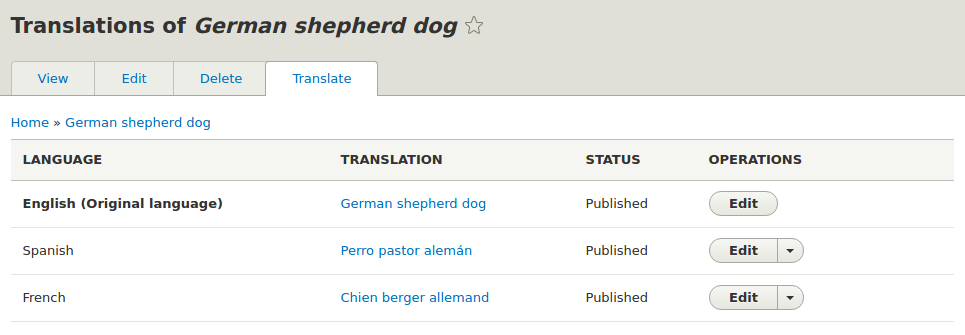Since the release of Drupal 8 with a standardized way of managing translations, many sites running Drupal 7 are making a switch to Drupal 8. In Drupal 7 there are two ways to translate content:
- Using the content_translation module. The D7 core way of translating content, where every translation is a separate node.
- Using the entity_translation module. Maintains one node with a unique
nid, while translations take place at the field level.
In this article we will discuss how to migrate content translations created with the content_translation module from Drupal 7 to Drupal 8. You can find our tutorial about migrating translations that use Entity Translation here.
This article would not have been possible without the help of my colleague Dave. ¡Gracias Dave!
The problem
We have a Drupal 7 database containing article nodes, which might have translations in English, Spanish and French. Some of these nodes are language-neutral, i.e. non-translatable. Our target is to migrate the Drupal 7 nodes into a Drupal 8 website, preserving the translations.
Before we start
- Since this is an advanced migration topic, it is assumed you already know the basics of migration. If are new to migrations in Drupal 8, I recommend that you read about migrating basic data to Drupal 8 first.
- If you'd like to run the migrations in this example yourself, see the quick-start documentation in our drupal migration i18n example repository.
- The source website used in this example is Drupal 7.54.
- The destination website used in this example is Drupal 8.3.x. However, an alternative solution for earlier versions is included towards the end of the article.
The module
To write the migrations, we create a module - in our case, migrate_example_i18n. There's nothing special about the module declaration, except for the dependencies:
- migrate_plus and migrate_tools provide various features for defining and executing migrations.
- migrate_source_csv: Will be used for demonstrating migration of translated content from non-Drupal sources in an upcoming article.
- migrate_drupal: This module provides tools for migrating data from older versions of Drupal. It comes with Drupal 8.x core. Since this migration uses a Drupal 7 site as a source for its data, we need the migrate_drupal module.
How do translations work?
Before jumping into writing these migrations, it is important to mention that Drupal 7 and Drupal 8 translations work very differently. Here's the difference in a nutshell:
- Drupal 7: When we translate a node, a new node is created with a different ID. This translated node has a property named
tnid,which stores the ID of the original node, linking the two nodes together. For language-neutral or untranslated content, thetnidis set to 0. - Drupal 8: When we translate a node, no new node is created! The translation is saved in the fields of the original node, but with a different language code.
So just like we do when migrating translated content from Drupal 6 to Drupal 8, we create two migrations:
- The example_dog_base migration will migrate the original content of each node, untranslated.
- The example_dog_i18n migration will migrate only translations and associate them with original content created by example_dog_base.
We group the two migrations using the example_dog migration group to keep things clean and organized. Then we can execute both migrations with drush migrate-import --group=example_dog --update.
Step 1: Base migration
We start with example_dog_base to migrate all base data or non-translations. Described below are some noteworthy parameters:
Source
source:
plugin: d7_node
node_type: article
key: drupal_7_content
constants:
uid_root: 1
node_article: 'article'- plugin: Since we want to import data from a Drupal installation, we need to set the source plugin to
d7_node. Thed7_nodesource plugin is introduced by themigrate_drupal, module and it helps us read nodes from a Drupal 7 database without having to write queries manually. Since Drupal 8.3.x, this plugin supports translations created with the content_translation module. If you are using an older version of Drupal 8, then check the alternative solution provided towards the end of this article. - node_type: This tells the source plugin that we are interested in just one particular Drupal 7 node type, namely article.
- key: Our Drupal 7 data doesn't come from our main Drupal 8 database - instead it comes from a secondary database connection. We choose a key to identify each such connection and we need to tell the source which such key to use. The keys themselves are defined in the
$databasesvariable in oursettings.phporsettings.local.php. See the example settings.local.php file to see how it's done. - constants: We define some hard-coded values under this parameter.
- translations: Notice there is no
translationsparameter here. The default value (false)tells the source plugin that we're only interested in migrating non-translations, i.e. content in the base language and language-neutral content.
Destination
destination:
plugin: 'entity:node'- plugin: Since we want to create node entities in Drupal 8, we specify this as
entity:node. That's it. - translations: Again we do not define the translations parameter while migrating base data. Omitting the parameter tells the destination plugin that we are interested in creating fresh nodes for each record, not translations of existing nodes.
Process
type: constants/node_article
langcode:
plugin: default_value
source: language
default_value: und
uid: constants/uid_root
title: title
body: body
field_one_liner: field_one_liner
sticky: sticky
status: status
promote: promoteThis is where we map the old node properties to the new node properties. Most of the properties have been assigned as is, without alteration, however, some noteworthy properties have been discussed below:
- nid: There is no
nidparameter here, because we don't care what nid each new node has in Drupal 8. Drupal can just assign a new nid to each node in the normal way. - type: We specify that we want to create article nodes.
- langcode: The
langcodeparameter was formerlylanguagein Drupal 7, so we rename it here. Also, if a Drupal 7 node is language-neutral, thelanguageproperty will have no value. In that case, we default tound.
This takes care of the base data. If we run this migration with drush migrate-import example_hybrid_base --update, all Drupal 7 nodes which are in base language or are language-neutral will be migrated into Drupal 8.
Step 2: Translation migration
We are halfway through now! All that's missing is migrating translations of the nodes we migrated above. To do this, we create another migration with the ID example_dog_i18n:
source:
plugin: d7_node
node_type: article
translations: true
# ...
destination:
plugin: 'entity:node'
translations: true
process:
nid:
plugin: migration
source: tnid
migration: example_dog_base
langcode: language
# ...
migration_dependencies:
required:
- example_dog_base- source:
- translations: We set this to
trueto make the source plugin read only translations.
- translations: We set this to
- destination:
- translations: We set this to
trueto make the destination plugin create translations for existing nodes instead of creating fresh new nodes.
- translations: We set this to
- process:
- nid: In this case, we do care what the Drupal 8
nidis for each node. It has to match thenidfor the untranslated version of this content, so that Drupal can add a translation to the correct node. This section uses themigration(migration_lookup) process plugin to figure out the rightnid. It tells Drupal to check the previously-executedexample_hybrid_basemigration for a D6 node that has the sametnidas this D6 node. It will then then reuse the resultingnidhere. - langcode: We define the language in which the translation should be created.
- nid: In this case, we do care what the Drupal 8
- migration_dependencies: Since we cannot add translations to nodes that do not yet exist, we tell Drupal that this migration depends on the base migration
example_dog_base. That way, the base migration will run before this migration.
That's it! We can run our translation migration with drush migrate-import example_dog_i18n --update and the translations will be imported into Drupal 8. Alternatively, we can use the migration group we defined to run both these migrations at once - the base migration will automatically be executed first and then the i18n migration. Here's how the output should look:
$ drush migrate-import --group=example_dog --update
Processed 7 items (7 created, 0 updated, 0 failed, 0 ignored) - done with 'example_dog_base'
Processed 7 items (7 created, 0 updated, 0 failed, 0 ignored) - done with 'example_dog_i18n'You can check if everything went alright by clicking the Translate option for any translated node in Drupal 8. If everything went correctly, you should see that the node exists in the original language and has one or more translations.

Alternate Solution for Drupal 8.2.x and Older
The example code for this article works out of the box with Drupal 8.3 or higher. However, it will not work with earlier versions of Drupal 8. For Drupal 8.2 or older, we need to use a custom source plugin (inspired by the d6_node plugin). All we have to do is use the D7NodeContnentTranslation source plugin included in the code for this example, like source: d7_node_content_translation. This custom source plugin adds support for the translations parameter, which in turn makes the migration of content translations work correctly.
Next Steps
- View the code for the migrate_example_i18n project on GitHub.
- Read about migrating entity translations from Drupal 7 to Drupal 8.
- Read about migrating translated content from Drupal 6 to Drupal 8.
- Read about migrating translations from CSV, JSON or XML to Drupal 8.
- New to Drupal 8 migrations? Start with Drupal 8 migration basics.

